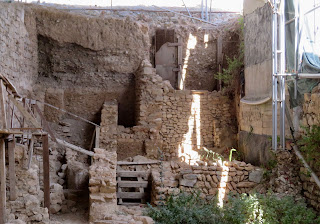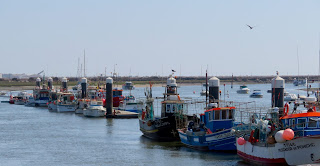 |
| Alvor mudflats |
 |
| The 16th-century Main Church of Alvor |
If we were going to move to Portugal, Tavira would be the city. Within an hour or so of walking around, we were both enthralled. It's hard to pinpoint exactly what the lure of the city was for us, but perhaps it was its peaceful nature. Everywhere else we had visited in Portugal was inundated with tourists. Located roughly 15 miles west of the Spanish border, most tourists don't travel this far east. The Gilão River flowing through the center of town and then on to the Ria Formosa Nature Park is a highlight. Historic churches, the city wall, and the labyrinth of the cobblestone streets were all places we explored. The Mercado Municipal Tavira was located a 5-minute walk from our B and B. The market provides fresh catch from the areas fishing fleet. There was an extensive and reasonably priced selection available. Fresh fruits and vegetables, local honey, and salt from the nearby national park were also sold. Unfortunately, we weren't able to do any cooking at the place we were staying, so we were unable to take advantage of the offerings. But numerous, small family restaurants in town provided ample choices of seafood.
 |
| Santa Luzia waterfront |
On departing Tavira, we stopped for a while in Santa Luzia. Considered part of the city of Tavira, it is also known as the "capital of octopus". Dozens of boats were lining the waterfront, some fishermen were still unloading their catch, but most were finished work for the day. Though it was almost noon, it was still too early in the day for the eateries along the water to open, so octopus was not going to be on our lunch menu for the day. We turned the car north and headed for Évora.
 |
| Ponte Romana bridge over the Gilão River |
 |
| An archeological dig of 15th-century home in Tavira |
 |
| Octopus and other options at the Tavira market |
 |
| Tavira Castle and city wall |
 |
| Tavira Castle |
 |
| View from atop the city wall in Tavira |



No comments:
Post a Comment